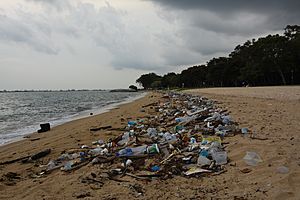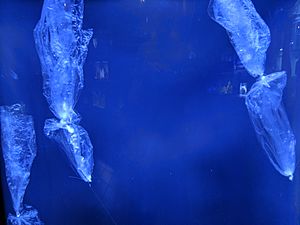Garbage patch facts for kids
A garbage patch is a collection of plastic and other debris particles from human activity that end up in the ocean and become mobile. Blown by the wind, or following the flow of ocean currents, garbage patches accumulate where currents are weakest. Such patches contaminate oceans with toxic chemicals, affect marine life and contribute to greenhouse gas emissions.
The United Nations Environmental Program estimated that "for every square mile of ocean" there are about "46,000 pieces of plastic."
The 10 largest emitters of oceanic plastic pollution worldwide are China, Indonesia, Philippines, Vietnam, Sri Lanka, Thailand, Egypt, Malaysia, Nigeria, and Bangladesh, largely through the rivers Yangtze, Indus, Yellow, Hai, Nile, Ganges, Pearl, Amur, Niger, and the Mekong, and accounting for "90 percent of all the plastic that reaches the world's oceans." Asia was the leading source of mismanaged plastic waste, with China alone accounting for 2.4 million metric tons.
Contents
Identified patches
In 2014, there were five areas across all the oceans where the majority of plastic concentrated. Researchers collected a total of 3070 samples across the world to identify hot spots of surface level plastic pollution. The pattern of distribution closely mirrored models of oceanic currents with the North Pacific Gyre, or Great Pacific Garbage Patch, being the highest density of plastic accumulation. The other four garbage patches include the North Atlantic garbage patch between the North America and Africa, the South Atlantic garbage patch located between eastern South America and the tip of Africa, the South Pacific garbage patch located west of South America, and the Indian Ocean garbage patch found east of south Africa.
Great Pacific
The Great Pacific garbage patch (also Pacific trash vortex and North Pacific Garbage Patch) is a garbage patch, a gyre of marine debris particles, in the central North Pacific Ocean. It is located roughly from 135°W to 155°W and 35°N to 42°N. The collection of plastic and floating trash originates from the Pacific Rim, including countries in Asia, North America, and South America.
Despite the common public perception of the patch existing as giant islands of floating garbage, its low density (4 particles per cubic metre (3.1/cu yd)) prevents detection by satellite imagery, or even by casual boaters or divers in the area. This is because the patch is a widely dispersed area consisting primarily of suspended "fingernail-sized or smaller"—often microscopic—particles in the upper water column known as microplastics. Researchers from The Ocean Cleanup project claimed that the patch covers 1.6 million square kilometres (620 thousand square miles) consisting of 45–129 thousand metric tons (50–142 thousand short tons) of plastic as of 2018. The same 2018 study found that, while microplastics dominate the area by count, 92% of the mass of the patch consists of larger objects which have not yet fragmented into microplastics. Some of the plastic in the patch is over 50 years old, and includes items (and fragments of items) such as "plastic lighters, toothbrushes, water bottles, pens, baby bottles, cell phones, plastic bags, and nurdles."
Research indicates that the patch is rapidly accumulating. The patch is believed to have increased "10-fold each decade" since 1945. The gyre contains approximately six pounds of plastic for every pound of plankton. A similar patch of floating plastic debris is found in the Atlantic Ocean, called the North Atlantic garbage patch. This growing patch contributes to other environmental damage to marine ecosystems and species.South Pacific
Indian Ocean
North Atlantic
Environmental issues
Photodegradation of plastics

The North Atlantic patch is one of several oceanic regions where researchers have studied the effects and impact of plastic photodegradation in the neustonic layer of water. Unlike organic debris, which biodegrades, plastic disintegrates into ever smaller pieces while remaining a polymer (without changing chemically). This process continues down to the molecular level. Some plastics decompose within a year of entering the water, releasing potentially toxic chemicals such as bisphenol A, PCBs and derivatives of polystyrene.
As the plastic flotsam photodegrades into smaller and smaller pieces, it concentrates in the upper water column. As it disintegrates, the pieces become small enough to be ingested by aquatic organisms that reside near the ocean's surface. Plastic may become concentrated in neuston, thereby entering the food chain. Disintegration means that much of the plastic is too small to be seen. Moreover, plastic exposed to sunlight and in watering environments produce greenhouse gases, leading to further environmental impact.
Effects on marine life
The 2017 United Nations Ocean Conference estimated that the oceans might contain more weight in plastics than fish by the year 2050. Some long-lasting plastics end up in the stomachs of marine animals. Plastic attracts seabirds and fish. When marine life consumes plastic allowing it to enter the food chain, this can lead to greater problems when species that have consumed plastic are then eaten by other predators.
Animals can also become trapped in plastic nets and rings, which can cause death. Plastic pollution affects at least 700 marine species, including sea turtles, seals, seabirds, fish, whales, and dolphins. Cetaceans have been sighted within the patch, which poses entanglement and ingestion risks to animals using the Great Pacific garbage patch as a migration corridor or core habitat.
Plastic consumption

With the increased amount of plastic in the ocean, living organisms are now at a greater risk of harm from plastic consumption and entanglement. Approximately 23% of aquatic mammals, and 36% of seabirds have experienced the detriments of plastic presence in the ocean. Since as much as 70% of the trash is estimated to be on the ocean floor, and microplastics are only millimeters wide, sealife at nearly every level of the food chain is affected. Animals who feed off of the bottom of the ocean risk sweeping microplastics into their systems while gathering food. Smaller marine life such as mussels and worms sometimes mistake plastic for their prey.
Larger animals are also affected by plastic consumption because they feed on fish, and are indirectly consuming microplastics already trapped inside their prey. Likewise, humans are also susceptible to microplastic consumption. People who eat seafood also eat some of the microplastics that were ingested by marine life. Oysters and clams are popular vehicles for human microplastic consumption. Animals who are within the general vicinity of the water are also affected by the plastic in the ocean. Studies have shown 36% species of seabirds are consuming plastic because they mistake larger pieces of plastic for food. Plastic can cause blockage of intestines as well as tearing of interior stomach and intestinal lining of marine life, ultimately leading to starvation and death.
Entanglement
Not all marine life is affected by the consumption of plastic. Some instead find themselves tangled in larger pieces of garbage that cause just as much harm as the barely visible microplastics. Trash that has the possibility of wrapping itself around a living organism may cause strangulation or drowning. If the trash gets stuck around a ligament that is not vital for airflow, the ligament may grow with a malformation. Plastic's existence in the ocean becomes cyclical because marine life that is killed by it ultimately decompose in the ocean, re-releasing the plastics into the ecosystem.
Deposits on landmasses
Research in 2017 reported "the highest density of plastic rubbish anywhere in the world" on remote and uninhabited Henderson Island in South Pacific as a result of the South Pacific Gyre. The beaches contain an estimated 37.7 million items of debris together weighing 17.6 tonnes. In a study transect on North Beach, each day 17 to 268 new items washed up on a 10-metre section.


